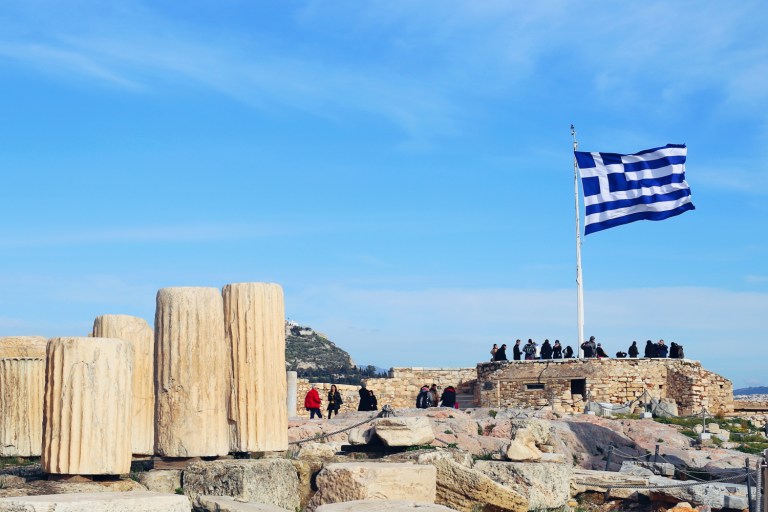RO: Daca si localnicii iti spun ca mai bine mergi pe jos decat sa iei metroul in Atena, atunci e clar. Preferi sa treci prin Omonia in miez de noapte decat sa fii cu ochii pe portofel de frica sa nu fii jefuit. Pe strazile un pic dubioase catre Monastiraki, cu blocurile in constructii ori reparatii, vanzatorii ambulanti de chinezisme, shaormerii (aaaah, pardon, “gyroserii”) la tot pasul, grafittiuri, gunoaie, praf si neasteptat de multi oameni ai strazii. Nu tocmai cea mai reprezentativa imagine a Greciei, dar hei, la capat de strada-i Monastiraki, floarea cea vestita a Atenei de la poalele Acropolelelor. Si slava cerului, se schimba putin foaia, si din toata dubiosenia de la doi pasi mai in spate, dam in cea mai turistica si comerciala zona a Atenei. Multa lume chiar si-acum, pe timp de iarna, multe buticuri, multe covoare colorate, condimente de tot soiul, suveniruri si mancaruri apetisante. Ruine antice, cladiri vechi de cand lumea si pamantul, cantareti la colt de strada, vanzatori amabili care nu stiu cum sa te atraga mai repede in magazinul lor de tinichele. Si adevarul e c-atunci cand te intampina cu un “Si fashi?” cand le zici c-ai venit din Romanica, te cam lasi cucerit. Macar pentru greci n-avem fete de rusi.
EN: If the locals tell you that it is better to walk instead of taking the metro in Athens, then it is clear. You should prefer going through Omonia Square in the middle of the night rather than always keeping an eye on your wallet to avoid being robbed. On the slightly dubious streets towards Monastiraki, with the buildings full of constructions or renovations, the barrow-men trying to sell you all kind of Chinese stuff, the shaorma shops (oooh, sorry, the gyros ones :D), the grafittis, the garbage and dust and the unexpected crowds. Not precisely the most representative image of Greece, but hey, at the end of the street we have Monastiraki, the famous neighborhood at the feet of the Acropolis. And luckily, we have a change of scenery, from all the dodgy area from two blocks behind we bump into the most touristy and commercial area of Athens. Lots of people even now, during wintertime, lots of boutiques and colorful rugs, all kind of spices and appealing foods. Ancient ruins, old buildings since forever, singers at every corner of the street, nice bargainers that try to attract you in their shops. And the truth is that when they hear you’re from Romania and they greet you with a typical Romanian phrase of “How do you do”, you end up mesmerized. At least for the Greeks we don’t look like Russians.



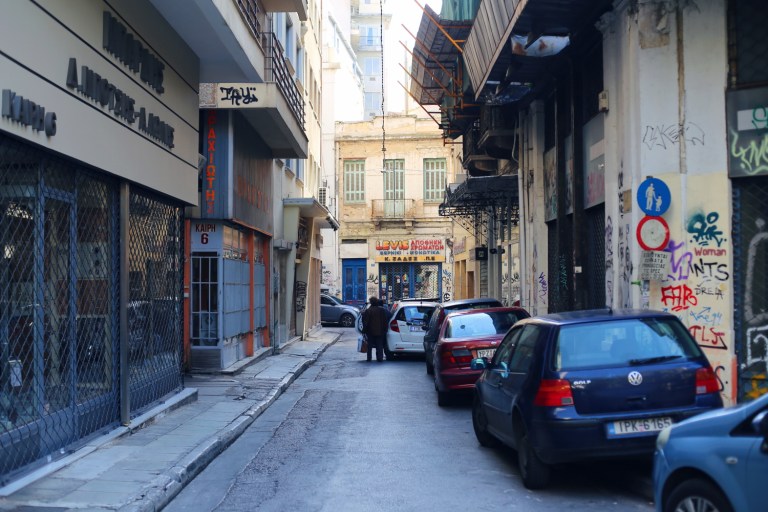
RO: Bun, ne-am lamurit. La Omonia mai rarut ca-i mai dragut, in schimb la Monastiraki, la baza Acropolelor, sa tot pierzi timpul printre tarabele pline de diverse. Un fel de bazar turcesc cu de toate pentru toti, ca doar nu s-or fi dus pe apa Sambetei cei 400 de ani de dominatie turceasca, fara sa-si lase macar un pic amprenta pe Atena cea actuala. Apropo, ca tot veni vorba de turci, ia sa dezbatem putin provenienta baclavalei. Ca prea o gasesti la tot pasul prin Atena 🙂 Cui i-a venit ideea geniala sa puna un strat subtire de aluat, unul de nuci si o tona de miere pe deasupra? Ei bine, nu se stie. Atata doar ca daca te trezesti in vreo taverna greceasca si te apuca curiozitatea sa intrebi de ce baclavaua e listata la deserturi traditionale in meniu, clar nu-i a buna. Si daca vrei sa dai cu bata-n balta si mai rau, intreaba ce-i aia “cafea greceasca” si de ce pare sa fie identica cu o cafea turceasca. Ca nu mai ai ce cauta in Grecia 😛
EN: Ok, so we clarified this. We should avoid Omonia, but we should wander the streets of Monastiraki, looking at all the shops full of all kind of stuff. A type of Turkish bazaar with everything you have imagined, as what do you know, those 400 years of Turkish domination were not in vain! By the way, speaking of Turkish people, let’s talk about the provenience of the baklava. As you simply find it everywhere in Athens 🙂 Who had the genius idea to put together a thin layer of dough, a layer of nuts and o ton of honey on top of it? Well, we don’t know. Just note that if you’re in a Greek tavern and you’re wondering why is the baklava listed under the traditional desserts menu, that’s not quite a good thing. And if you want to screw it up even worse, ask the waiters what’s that a “Greek coffee” and why does it seem identical with the Turkish one. It will probably be your last time in Greece 😛


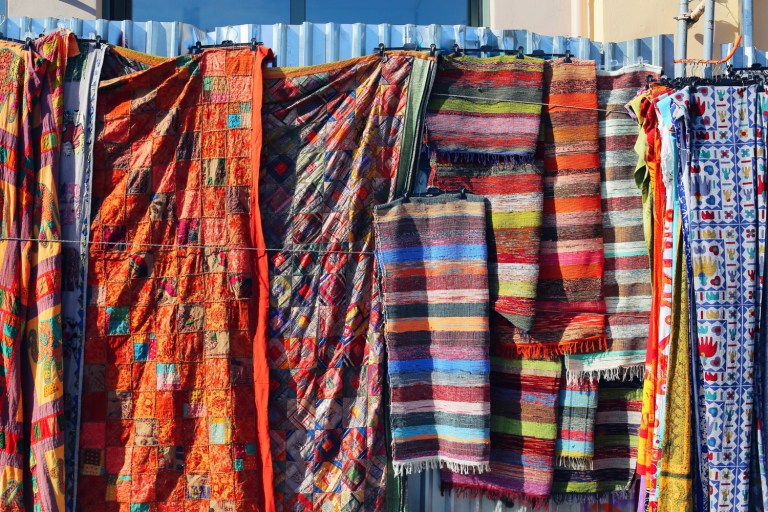
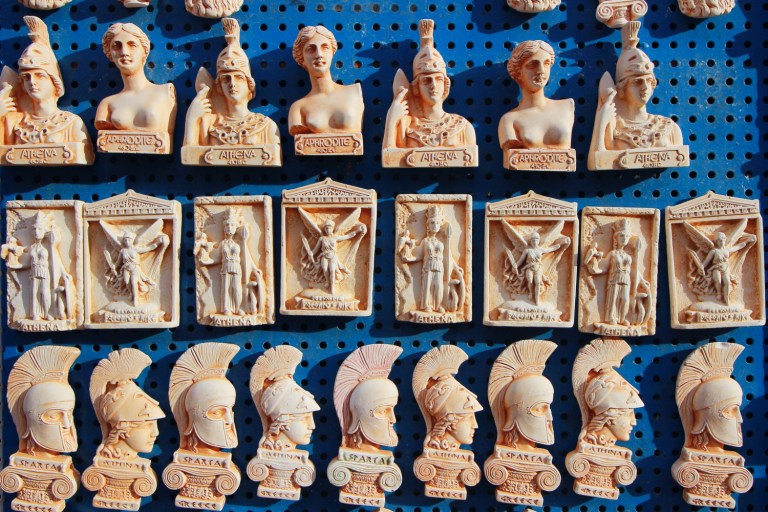
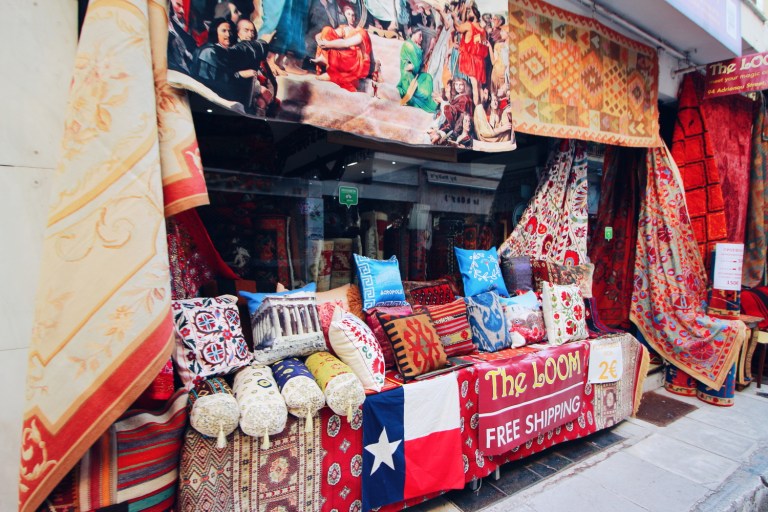

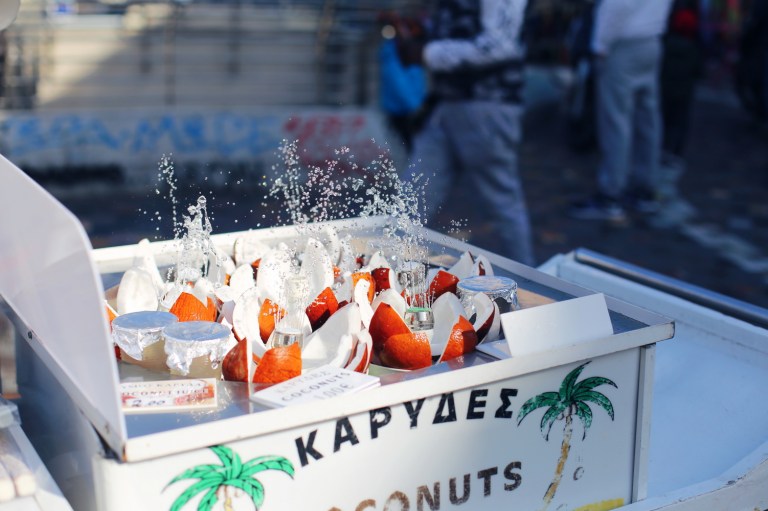

RO: Dar hei, plecasem de la Monastiraki si-am facut ce am facut si am ajuns la “galcevele” dintre turci si greci. Revenim. Lasam Monastiraki-ul si ale lui tarabe si agitatie in spate si-o luam in sus, pe stradute, inspre Acropole. Si dam de Plaka, in sfarsit! Un cartier vechi de cand lumea, cu strazi inguste de abia-ti incape un Smart pitic, pante abrupte, multe restaurante si terase deschise fix pe treptele ce duc spre Acropole. Pai care-i baiul? Zona e intr-adevar cam turistica si comerciala, dar arata intr-un mare fel. Si daca initial Atena te lasa putin rece cand vezi atata beton, trafic si mizerie, ei bine, in Plaka iti revii. Si dai de atmosfera aia tipic greceasca pe care o cautai.
EN: But hey, we started from Monastiraki and we got to the quarrels between Turkish and Greek people. Let’s go back. We leave behind the Monastiraki neighborhood, its bazaar shops and all the hustle and bustle and we go up on the streets, towards the Acropolis. And we finally get to Plaka! An old neighborhood, with narrow streets that it’s hard to drive even a small Smart in here, steep hillsides, lots of restaurants and terraces opened right on the stairs that lead to the Acropolis. This area is indeed a bit too touristy and commercial, but it looks fabulous. And if initially you tend to be a bit disappointed by Athens with all its concrete, traffic and misery, in Plaka you get on your feet again. And you find that typically Greek atmosphere that you were searching for.
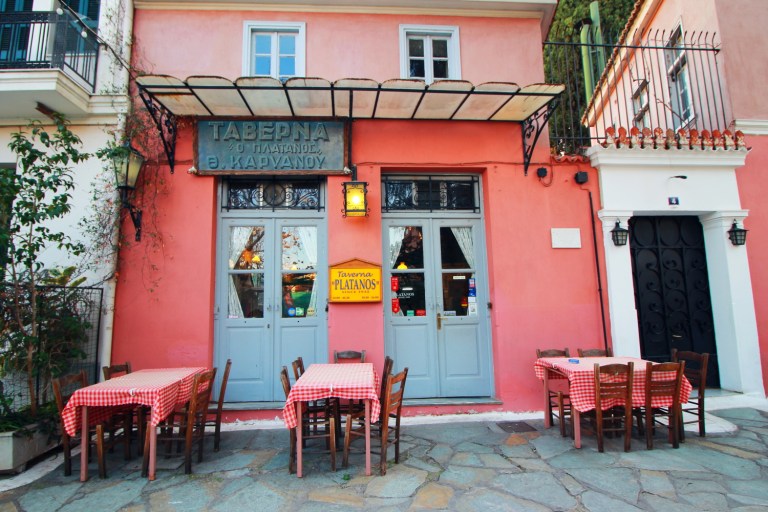



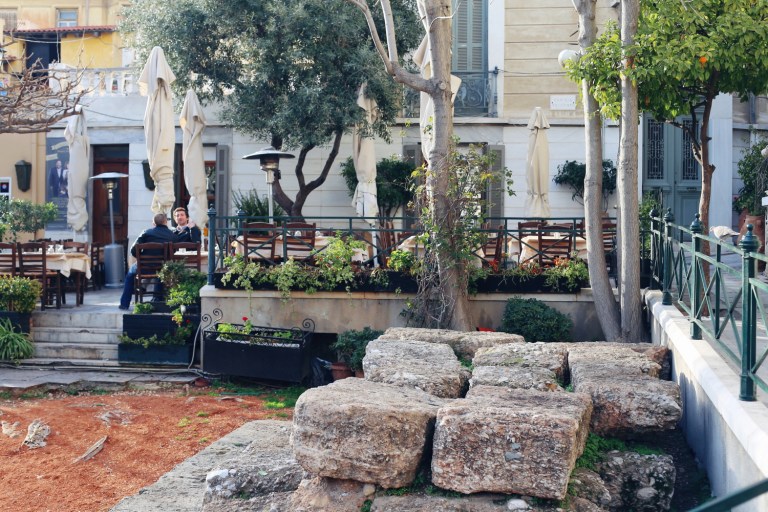



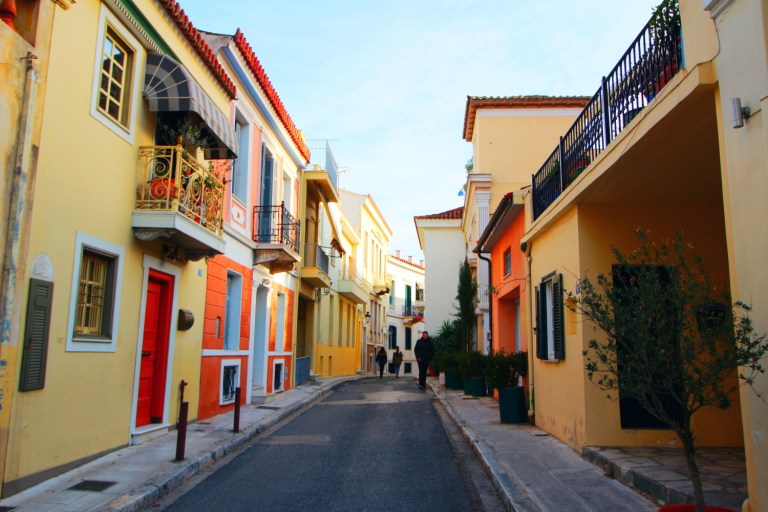





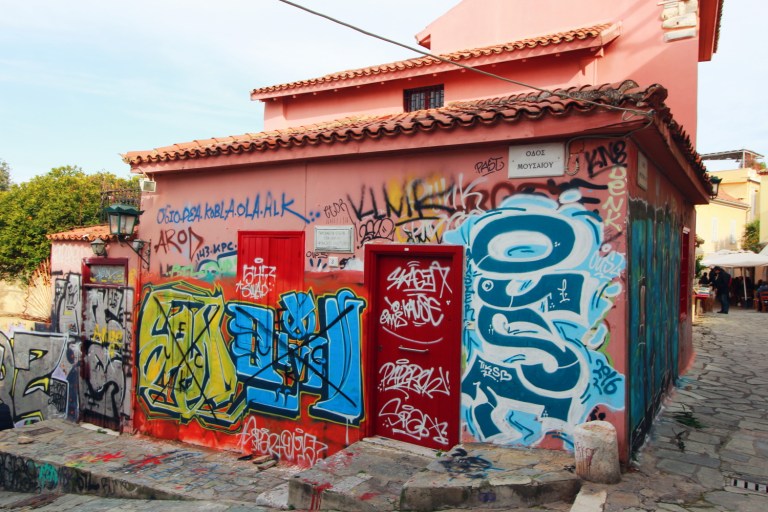



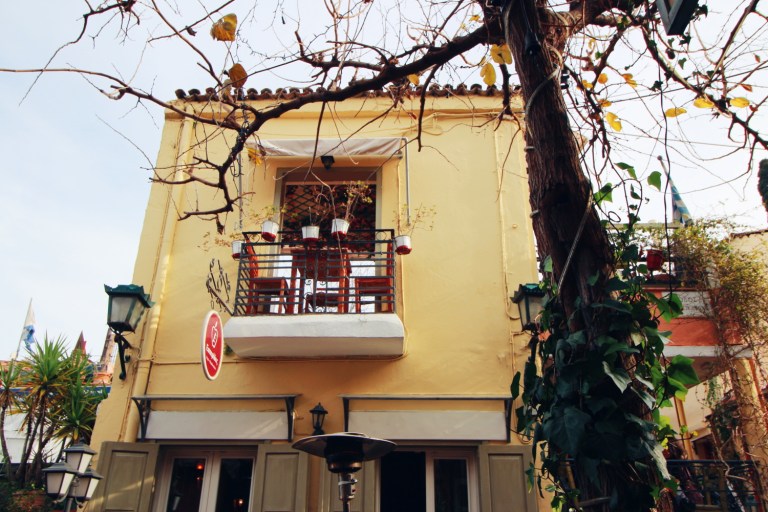
RO: A, si apropo, in caz ca ti se face subit dor si pofta de o insula greceasca, Anafiotika are fix ce-i trebuie cat sa te convinga ca esti pe vreo alee dosita de prin Santorini. Case albe insirate la poalele Acropolelor, drumuri inguste, trepteeee, multe trepte si gradini ingrijite. Anafiotika e tot parte din Plaka, dar mai inspre nord.
EN: Ah, and by the way, just in case you’re suddenly longing for some Greek island, Anafiotika has everything that you need to be convinced that you’re on a side alley in Santorini. White houses at the feet of the Acropolis, narrow alleys, staaaaaairs, tons of stairs and nice gardens. Anafiotika is still part of Plaka, but just a bit up north.


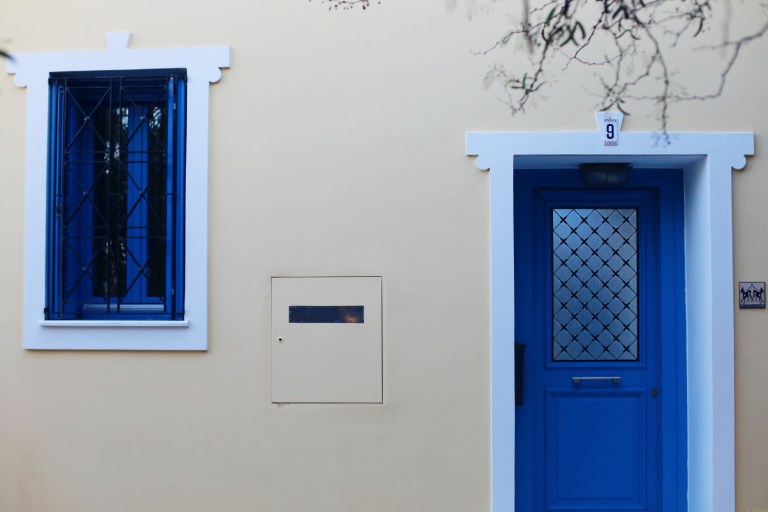




RO: Ok, hai c-am scris ditai romanul si inca n-am ajuns la subiect. Si-anume la Acropole. Incepem si noi cu “teoria”, ca sa lamurim ca Acropolele nu sunt templele de pe deal, ci dealul in sine. Si-or fi cate si mai cate alte Acropole pe pamant grecesc, insa numai una-i cea din toate cartile postale si toate pozele de pe internet. Orasul (polis) de pe dealul (acros) Atenei, cu Partenonul si Erehteionul (ambele dedicate zeitei Atena), e cu siguranta cea mai emblematica imagine a Greciei. Nu degeaba i se spune “Stanca Sacra”, si nu degeaba este simbolul Epocii de Aur a Atenei, cand Pericle a facut el ce-a facut si-a adus orasul pe culmea prosperitatii! Gata, am lamurit! Atena e un fel de Roma greceasca, si fiecare bucatica de pamant, fiecare pietroi, fiecare ruina e incarcata de istorie si povesti.
EN: Ok, we already wrote a novel and we still did not get to the point of this article. Which is the Acropolis. And we’re starting with the “theory”, to clarify that the Acropolis are not the temples from up the hill, but the hill itself. And maybe there are lots of other Acropolis all around Greece, but there’s only one on the postcards and in the pictures on the internet. The city (polis) from up the hill (acros) of Athens, with its Parthenon and Erechtheion (both dedicated to Athena goddess), it is for sure the most iconic image of Greece. They even call it the “Sacred Rock” and it is the symbol of the Golden Era of Athens, when Pericles did what he did and brought prosperity to the city. Ok, we’re clear now! Athens is a kind of Greek Rome, and each piece of land, each rock, each ruin is loaded with history and stories.




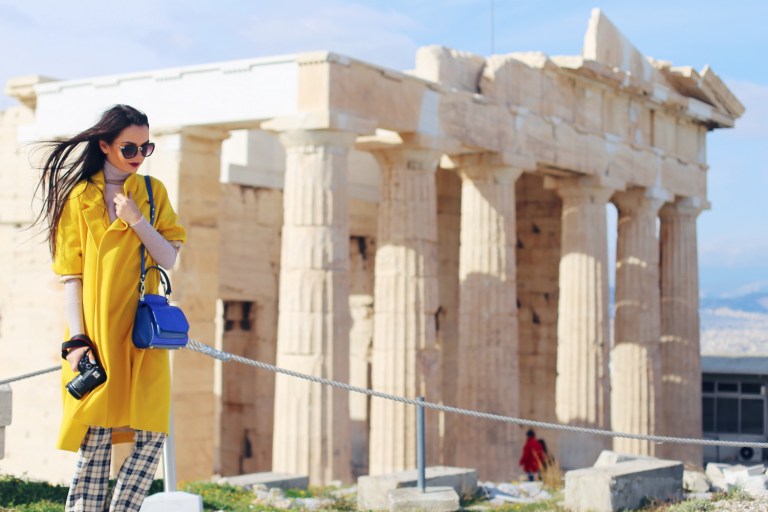


RO: Teatrul Herodes Atticus e primul pe drumul catre varful Acropolelor si-a fost renovat si dichisit cat sa poata tine 5000 de spectatori in amfiteatru si concerte de toata frumusetea in aer liber. Stiau ei romanii cum sta treaba cu acustica 😀 Si-adevarul e ca trebuie sa fi fost senzational sa-i auzi trilurile lui Pavarotti in mijlocul teatrului. Inca se mai tin concerte, festivaluri sau spectacole de teatru aici, iar din mai pana-n octombrie (cand nu te ia pe sus vantul din timpul iernii!), e o nebunie curata cu toate evenimentele culturale.
EN: The Herodes Atticus theater is the first one on the way to the top of the Acropolis and it has been renovated and “groomed” to hold 5000 spectators in the amphitheater and nice open-air concerts. Seems like the Romans knew how to deal with the acoustics 😀 And the truth is that it must have been great to listen to Pavarotti’s trills in the middle of the theater. They are still holding concerts here, festivals and theater shows, and from May until October (when it is not that windy as it was now :D), it’s a total madness with all the cultural events.


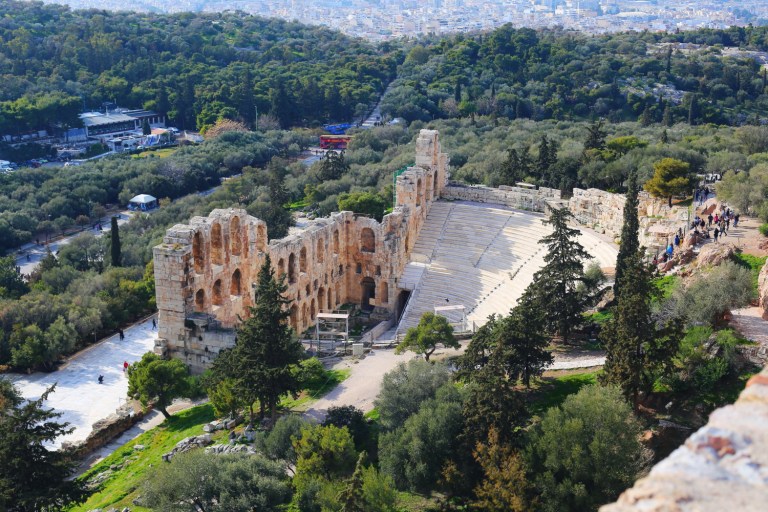
RO: Partenonul, desi in renovari de ani de zile (de prin 1983 mai exact) si plin de schele si lucrari de restaurare, e un mastodont cu toate coloanele uriase si masive, blocuri imense de marmura alba. Templul a fost dedicat Atenei, zeita intelepciunii si protectoarea orasului
EN: The Parthenon, even though is being renovated for years (since 1983 to be more precise), is full of scaffolds and restoration works, it’s a huge building with all those massive columns, immense chunks of white marble. The temple was built in honor of Athena, the Goddess of Wisdom and protector of the city.




RO: Si ca sa nu treaca neobservata “disputa” dintre Atena si zeul marilor, Poseidon, s-a construit si Erehteion-ul in cinstea amandurora. Iar piesa de rezistenta a templului o reprezinta cele 6 statui, asa numitele Cariatide. De par prea bine conservate si prea detaliate si perfecte, ei bine, nu sunt cele originale, ci niste copii. Cat despre Poseidon, ca i-o fi convenit sau nu schema cu impartitul faimei cu Atena, nu stim. Cert e ca de suparare sau nu, si-a construit si el propriul templu, in buza capului Sounion, pe o stanca in mare. Glumim, nu l-a construit el, ci un “trimis” de-al lui din Epoca de Aur 😀
EN: And because of the “quarrels” between Atena and Poseidon, the god of the seas, Erechtheion was built to honor both of them. And la piece de resistance of this temple is represented by those six statues, the so called Caryatids. And if they look perfectly preserved and too polished and detailed, oh well, these are not the originals, but some copies. As for Poseidon, we can’t say for sure if he liked the scheme with sharing the fame with Atena. But just to forget about all the sadness, he built his own temple, at the end of Cape Sounion, on a rock in the sea. We’re joking, he did not build it, but a “messenger” of his from the Golden Era 😀


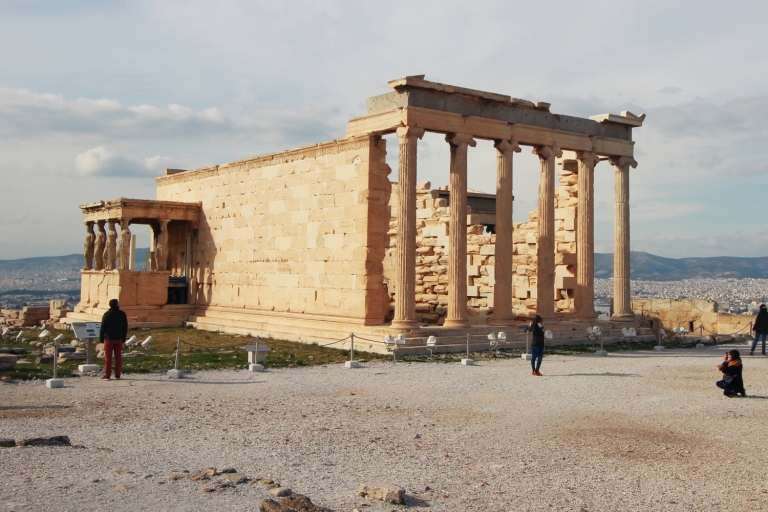


RO: Una peste alta, oricat de “prea” turistice ar fi Acropolele si oricat de scump sau nu ar fi biletul de intrare, templele sunt spectaculoase. Iar privelistea vazuta de sus, de pe deal, cu toata Atena intinsa cat vezi cu ochii, de parca nu se termina, e incredibila.
EN: All in all, no matter how touristy the Acropolis would be and no matter how expensive the entrance ticket would be, the temples are spectacular. And the view from up above, perched on the hill, with all the city laying as far as the eye can see as if it never ends, it’s simply magnificent.


